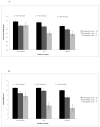Diabetes, peripheral neuropathy, and lower-extremity function
- PMID: 24120281
- PMCID: PMC3987662
- DOI: 10.1016/j.jdiacomp.2013.08.007
Diabetes, peripheral neuropathy, and lower-extremity function
Abstract
Objective: Diabetes among older adults causes many complications, including decreased lower-extremity function and physical disability. Diabetes can cause peripheral nerve dysfunction, which might be one pathway through which diabetes leads to decreased physical function. The study aims were to determine the following: (1) whether diabetes and impaired fasting glucose are associated with objective measures of physical function in older adults, (2) which peripheral nerve function (PNF) tests are associated with diabetes, and (3) whether PNF mediates the diabetes-physical function relationship.
Research design and methods: This study included 983 participants, age 65 years and older from the InCHIANTI study. Diabetes was diagnosed by clinical guidelines. Physical performance was assessed using the Short Physical Performance Battery (SPPB), scored from 0 to 12 (higher values, better physical function) and usual walking speed (m/s). PNF was assessed via standard surface electroneurographic study of right peroneal nerve conduction velocity, vibration and touch sensitivity. Clinical cutpoints of PNF tests were used to create a neuropathy score from 0 to 5 (higher values, greater neuropathy). Multiple linear regression models were used to test associations.
Results and conclusion: One hundred twenty-six (12.8%) participants had diabetes. Adjusting for age, sex, education, and other confounders, diabetic participants had decreased SPPB (β=-0.99; p<0.01), decreased walking speed (β=-0.1m/s; p<0.01), decreased nerve conduction velocity (β=-1.7m/s; p<0.01), and increased neuropathy (β=0.25; p<0.01) compared to non-diabetic participants. Adjusting for nerve conduction velocity and neuropathy score decreased the effect of diabetes on SPPB by 20%, suggesting partial mediation through decreased PNF.
Keywords: Geriatrics; Gerontology; Lower extremity function; Peripheral neuropathy.
© 2014.
Figures
References
-
- Centers for Disease Control and Prevention . National diabetes fact sheet: General information and national estimates on diabetes in the united states, 2007. 2008.
-
- Head K. Peripheral neuropathy: Pathogenic mechanisms and alternative therapies. Alternative medicine review. 2006;11(4):294–329. - PubMed
-
- Candrilli SD, Davis KL, Kan HJ, Lucero MA, Rousculp MD. Prevalence and the associated burden of illness of symptoms of diabetic peripheral neuropathy and diabetic retinopathy. J Diabetes Complications. 2007;21(5):306–314. doi: DOI: 10.1016/j.jdiacomp.2006.08.002. - PubMed
Publication types
MeSH terms
Grants and funding
LinkOut - more resources
Full Text Sources
Other Literature Sources
Medical


